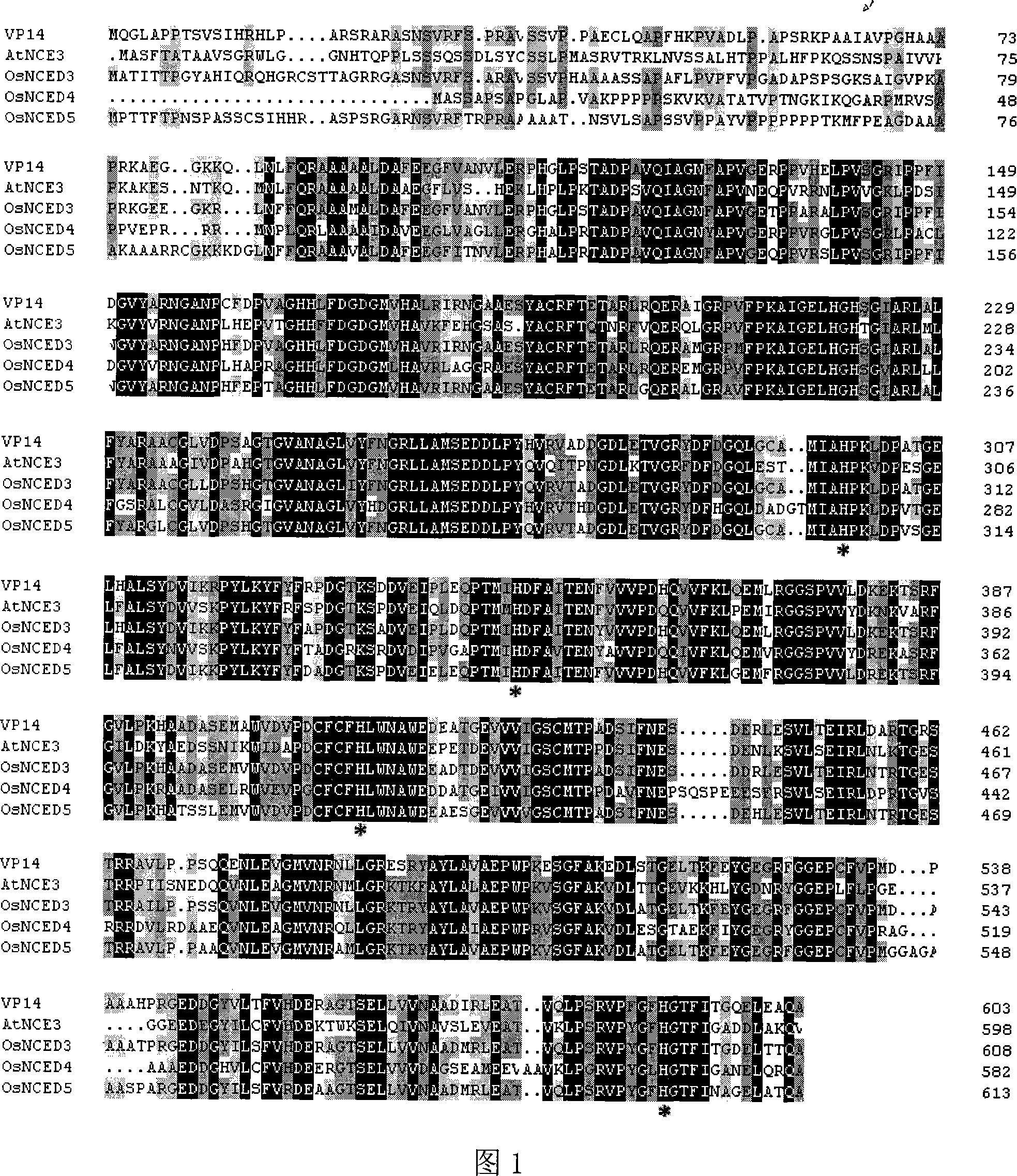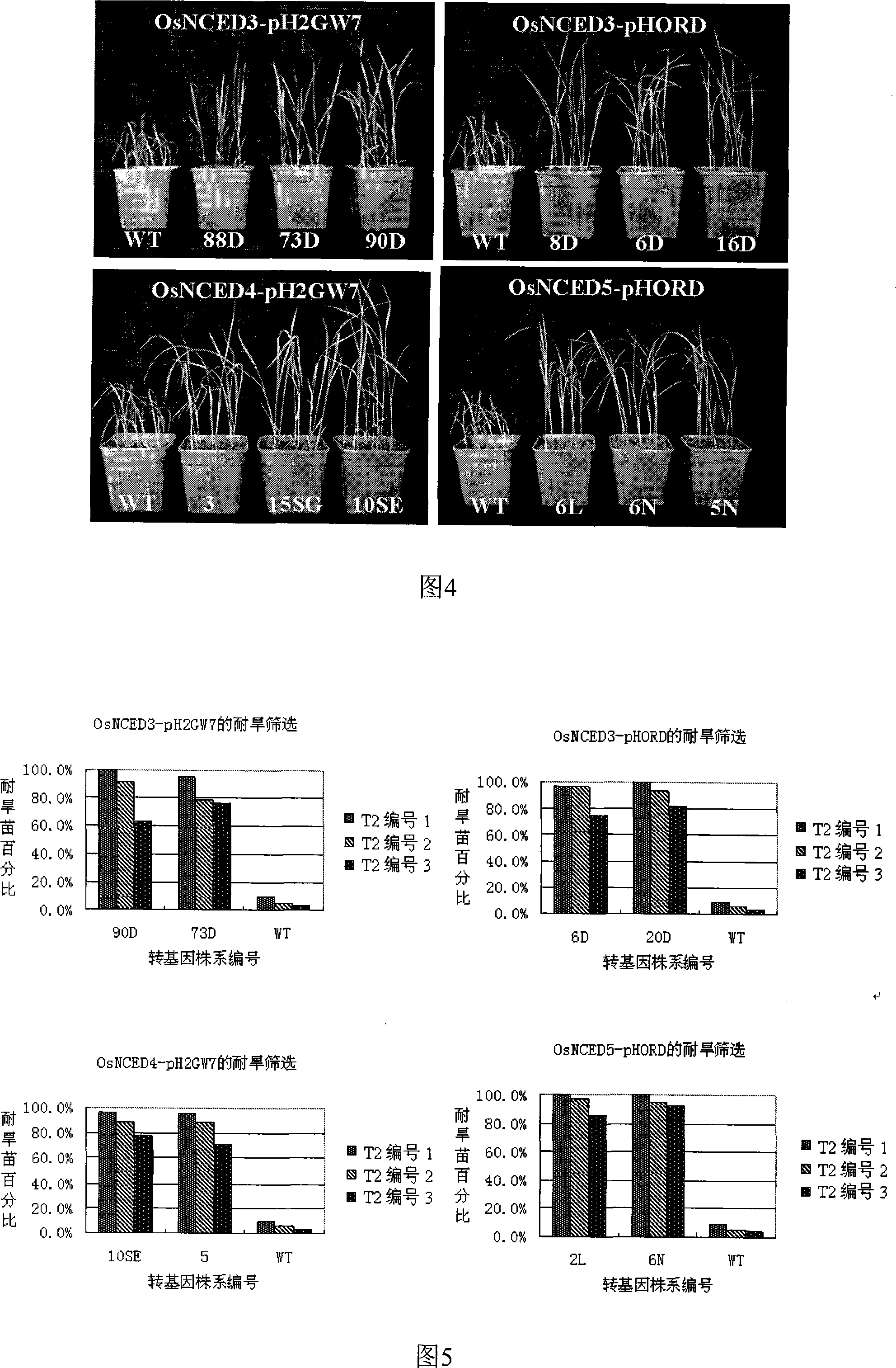Clone and application of a gene improving rice drought tolerance and relative with ABA synthesis
A technology of drought tolerance and genetics, applied in the field of cultivating plants with improved drought tolerance, can solve the problems of limited systematic research and less research, and achieve the effects of broad application prospects, improved drought tolerance, and improved tolerance
- Summary
- Abstract
- Description
- Claims
- Application Information
AI Technical Summary
Problems solved by technology
Method used
Image
Examples
Embodiment 1
[0069] Example 1. Obtaining drought tolerance genes OsNCEDs
[0070] 1. Obtaining the gene sequence
[0071] We used the cDNA sequence of Arabidopsis AtNCED3 as the basis for blast analysis in the rice genome database. Three OsNCEDs genes with high homology to AtNCED3 sequence were found, named OsNCED3 (AY838899), OsNCED4 (AY838900), OsNCED5 (AY838901).
[0072] 2. PCR amplification and sequence analysis of OsNCED3, OsNCED4 and OsNCED5
[0073] Using the total DNA of Oryza sativa “Zhonghua NO.11” as a template, the PCR method was used to amplify OsNCED3, OsNCED4, and OsNCED5. The primer sequences are as follows:
[0074] (1) Design primers according to the CDS sequence of OsNCED3:
[0075] OsNCED3-F 5’-CACCACAAAATGGCGACGATCACGACG-3’
[0076] OsNCED3-R 5’-GGCCTGGGTGGTGAGCTC-3’
[0077] (2) Design primers according to the CDS sequence of OsNCED4:
[0078] OsNCED4-F 5’-CACCACAAAATGGCGTCCTCCGCGCCTT-3’
[0079] OsNCED4-R 5’-AGCTTGTCGCTGCAGCTCGTT-3’
[0080] (3) Design primers according...
Embodiment 2
[0086] Example 2. Obtaining of transgenic rice with OsNCEDs genes related to drought tolerance in rice
[0087] The drought tolerance-related genes OsNCED3, OsNCED4 and OsNCED5 obtained in Example 1 were respectively transformed into rice by Agrobacterium-mediated method, and the specific methods are as follows:
[0088] 1) Construction of pHORD vector:
[0089] The pH2GW7 vector (Invitrogen's Gateway TM vector vector containing the CaMV 35S constitutive promoter) The CaMV 35S constitutive promoter in the Arabidopsis thaliana rd29A inducible promoter ( Narusaka Y, Nakashima K , Shinwari ZK , Sakuma Y , Furihata T , Abe H, Narusaka M , Shinozaki K , Yamaguchi-Shinozaki K .Interaction between two cis-acting elements, ABRE and DRE, inABA-dependent expression of Arabidopsis rd29A gene in response to dehydration and high-salinity stresses. Plant Journal, 2003, 34(2): 137-48.). Specific method: Using Arabidopsis genomic DNA as template, use rd29A-F1 (5'CACCGAGCTCATTTTCGTTCTTGACA...
Embodiment 3
[0096] Example 3. Genetic analysis and molecular identification of transgenic T1 rice plants
[0097] Take the OsNCED3-pH2GW7, OsNCED3-pHORD, OsNCED4-pH2GW7 and OsNCED5-pHORD T1 transgenic rice seeds harvested in Example 2, and soak the seeds in water for 3 days to germinate, and then use 50mg / L hygromycin for resistance screening. The non-transgenic rice Zhonghua 11 was used as a control. After 5 days of selection, all the control plants died. The number of resistant and dead seedlings of the transgenic plants was counted, the resistance segregation ratio of the transgenic plants was analyzed, and the separation of resistant and non-resistant seedlings was selected. For strains with a ratio of about 3:1, the results showed that OsNCED3-pH2GW7, OsNCED3-pHORD, OsNCED4-pH2GW7 and OsNCED5-pHORD transgenic strains with single point insertion were obtained.
[0098] Select the plants of the transgenic line inserted at the unit point with a growth period of 15 days, extract the total RN...
PUM
 Login to View More
Login to View More Abstract
Description
Claims
Application Information
 Login to View More
Login to View More - R&D
- Intellectual Property
- Life Sciences
- Materials
- Tech Scout
- Unparalleled Data Quality
- Higher Quality Content
- 60% Fewer Hallucinations
Browse by: Latest US Patents, China's latest patents, Technical Efficacy Thesaurus, Application Domain, Technology Topic, Popular Technical Reports.
© 2025 PatSnap. All rights reserved.Legal|Privacy policy|Modern Slavery Act Transparency Statement|Sitemap|About US| Contact US: help@patsnap.com



